Researches
Field Experiment On Biological Contact Oxidation Process To Treat Polluted River Water In The Dianchi Lake Watershed
Views : 6
Source: https://www.springer.com/gp
Author: Lu Li, Shuguang Xie, Hui Zhang, Donghui Wen
Usually dispatched in 2 to 3 days
Usually dispatched in 2 to 3 days
Category:
Researches
In this study two types of biological contact oxidation processes (BCOP), a step-feed (SBCOP) unit and an inter-recycle (IBCOP) unit, were designed to investigate the treatment of heavily polluted river water. The Daqing River, which is the largest pollutant contributor to the Dianchi Lake, one of the most eutrophic freshwater lakes in China, was taken for the case study.
Only logged in customers who have purchased this product may leave a review.
Related books
Adsorption Characteristics of Multi-Metal Ions by Red Mud, Zeolite, Limestone and Oyster Shell
Abstract
In this study, the performance of different adsorbents—red clay, zeolite, limestone, and oyster shell—for adsorption of polymetallic ions (Cr3+, Ni2+, Cu2+, Zn2+, As3+, Cd2+, and Pb2+) were investigated from aqueous solutions.
Adsorption Characteristics of Multi-Metal Ions by Red Mud, Zeolite, Limestone and Oyster Shell
Abstract
In this study, the performance of different adsorbents—red clay, zeolite, limestone, and oyster shell—for adsorption of polymetallic ions (Cr3+, Ni2+, Cu2+, Zn2+, As3+, Cd2+, and Pb2+) were investigated from aqueous solutions.
Biofouling of Water Treatment Membranes: A Review of the Underlying Causes, Monitoring Techniques and Control Measures
Biofouling is a critical issue in membrane water and wastewater treatment as it greatly compromises the efficiency of the treatment processes. It is difficult to control, and significant economic resources have been dedicated to the development of effective biofouling monitoring and control strategies. This paper highlights the underlying causes of membrane biofouling and provides a review on recent developments of potential monitoring and control methods in water and wastewater treatment with the aim of identifying the remaining issues and challenges in this area.
Biofouling of Water Treatment Membranes: A Review of the Underlying Causes, Monitoring Techniques and Control Measures
Biofouling is a critical issue in membrane water and wastewater treatment as it greatly compromises the efficiency of the treatment processes. It is difficult to control, and significant economic resources have been dedicated to the development of effective biofouling monitoring and control strategies. This paper highlights the underlying causes of membrane biofouling and provides a review on recent developments of potential monitoring and control methods in water and wastewater treatment with the aim of identifying the remaining issues and challenges in this area.
Adsorption of Heavy Metals from Multi-Metal Aqueous Solution by Sunflower Plant Biomass-Based Carbons
Abstract
This study reports the competitive adsorption
of Ni(II), Cd(II) and Cr(VI) onto sunflower waste biomass
carbons, viz. sunflower head carbon and sunflower stem
carbon from multi-metal aqueous solution.
Adsorption of Heavy Metals from Multi-Metal Aqueous Solution by Sunflower Plant Biomass-Based Carbons
Abstract
This study reports the competitive adsorption
of Ni(II), Cd(II) and Cr(VI) onto sunflower waste biomass
carbons, viz. sunflower head carbon and sunflower stem
carbon from multi-metal aqueous solution.
Fouling and Cleaning Characteristics of Reverse Osmosis (RO) Membranes
Abstract:
This work deals with fouling and successive cleaning of RO membrane fouled by an organic foulant, sodium alginate using a laboratory-scale cross flow test unit. First, spiral-wound RO membrane was fouled with sodium alginate solution up to 10% and 15%, respectively at an applied pressure of 1380 kPa with flow rate of 10 lit/min. An anionic surfactant, sodium dodecyl sulfate (SDS) was used as a chemical cleaning agent for cleaning of RO membrane. The effect of cleaning chemical dose and cross-flow velocity on the membrane chemical cleaning duration to achieve 100% cleaning efficiency (i.e., to get original water flux) was also investigated. As the SDS concentration increases, the membrane chemical cleaning time decreases due to increase in the solubility of the foulant (when the surface tension decreases by an increase in the SDS concentration). Furthermore, the membrane chemical cleaning time decreases with increasing cross-flow velocity of the cleaning chemical solution (SDS). Higher cross-flow velocity enhances the turbulence at the fouling layer and hence the mass transfer of the foulant from the fouling layer to the bulk solution is improved, then the SDS has weakened the structural integrity of the fouling layer. It is observed that better cleaning is occurred with higher concentration of SDS and flow rate. The obtained results clearly reveal that SDS cleaning is proved to be an efficient cleaning method for RO membranes fouled with organic foulant.
Fouling and Cleaning Characteristics of Reverse Osmosis (RO) Membranes
Abstract:
This work deals with fouling and successive cleaning of RO membrane fouled by an organic foulant, sodium alginate using a laboratory-scale cross flow test unit. First, spiral-wound RO membrane was fouled with sodium alginate solution up to 10% and 15%, respectively at an applied pressure of 1380 kPa with flow rate of 10 lit/min. An anionic surfactant, sodium dodecyl sulfate (SDS) was used as a chemical cleaning agent for cleaning of RO membrane. The effect of cleaning chemical dose and cross-flow velocity on the membrane chemical cleaning duration to achieve 100% cleaning efficiency (i.e., to get original water flux) was also investigated. As the SDS concentration increases, the membrane chemical cleaning time decreases due to increase in the solubility of the foulant (when the surface tension decreases by an increase in the SDS concentration). Furthermore, the membrane chemical cleaning time decreases with increasing cross-flow velocity of the cleaning chemical solution (SDS). Higher cross-flow velocity enhances the turbulence at the fouling layer and hence the mass transfer of the foulant from the fouling layer to the bulk solution is improved, then the SDS has weakened the structural integrity of the fouling layer. It is observed that better cleaning is occurred with higher concentration of SDS and flow rate. The obtained results clearly reveal that SDS cleaning is proved to be an efficient cleaning method for RO membranes fouled with organic foulant.
Water Desalination Using Solar Thermal Collectors Enhanced by Nanofluids
Introduction
In the future, the world is confronted with energy and freshwater shortage. Desalination of brackish or seawater is one of the most important ways to solve the water scarcity issue [1, 2]. The use of solar energy or waste heat sources is acceptable for water-producing systems of such a small size [3–5]. The relevancy of nanomaterials is to realize the best attainable properties within the smallest possible loadings through homogenized distribution and stable suspension of these nanoparticles[6–11]. Often, heat transfer improvement in solar collectors is one of the basic problems in energy saving, compact designs, and different operating temperatures. Researchers also investigated the multiwalled carbon nanotubes (MWCNTs) and water nanofluids with a pH of 3.5, 6.5, and 9.5, and Triton X-100 as a surfactant (0.2 wt %) using flat-plate solar collectors. It was found that the nanofluids have better heat transfer performance in acidic and alkaline water due to the influence of the isoelectric point. The higher efficiency (67 %) was obtained at pH 9.5 and 3.5 with a water flow rate of 0.0333 kg s–1. A stable nanofluid based on ethylene glycol-containing nanosheets of graphene oxide was prepared by Yu et al. [12]. The improvement in thermal conductivity relies strongly on the volume fraction of the nanosheet of graphene oxide and increases with higher nanoparticle loading. The heat efficiency was enhanced up to 61.0 % using a nanosheet loading of 5.0 vol %. For seven days, the thermal conductivity of the fluids remained almost constant, which suggests their high stability. In the measured temperature range, the enhancement value was independent of the temperature. Peyghambarzadeh et al. [13, 14] studied force convection techniques in an excessively base water nanofluid, which was experimentally compared to water in a vehicle heat exchanger with different nanofluid loadings. It was experimentally investigated to improve the rate of heat transfer. The variable effect of the inlet temperature of the fluid in the heat exchanger on the heat transfer coefficient was evaluated. The findings showed that the incremental fluid circulation rate would increase the output rate of heat transfer, while the temperature of the fluid entering the heat exchanger had negligible effects. Meanwhile, water nanofluid subservience at low-volume loadings would increase the heat transfer rate efficiency by approximately 44 % compared to water
Water Desalination Using Solar Thermal Collectors Enhanced by Nanofluids
Introduction
In the future, the world is confronted with energy and freshwater shortage. Desalination of brackish or seawater is one of the most important ways to solve the water scarcity issue [1, 2]. The use of solar energy or waste heat sources is acceptable for water-producing systems of such a small size [3–5]. The relevancy of nanomaterials is to realize the best attainable properties within the smallest possible loadings through homogenized distribution and stable suspension of these nanoparticles[6–11]. Often, heat transfer improvement in solar collectors is one of the basic problems in energy saving, compact designs, and different operating temperatures. Researchers also investigated the multiwalled carbon nanotubes (MWCNTs) and water nanofluids with a pH of 3.5, 6.5, and 9.5, and Triton X-100 as a surfactant (0.2 wt %) using flat-plate solar collectors. It was found that the nanofluids have better heat transfer performance in acidic and alkaline water due to the influence of the isoelectric point. The higher efficiency (67 %) was obtained at pH 9.5 and 3.5 with a water flow rate of 0.0333 kg s–1. A stable nanofluid based on ethylene glycol-containing nanosheets of graphene oxide was prepared by Yu et al. [12]. The improvement in thermal conductivity relies strongly on the volume fraction of the nanosheet of graphene oxide and increases with higher nanoparticle loading. The heat efficiency was enhanced up to 61.0 % using a nanosheet loading of 5.0 vol %. For seven days, the thermal conductivity of the fluids remained almost constant, which suggests their high stability. In the measured temperature range, the enhancement value was independent of the temperature. Peyghambarzadeh et al. [13, 14] studied force convection techniques in an excessively base water nanofluid, which was experimentally compared to water in a vehicle heat exchanger with different nanofluid loadings. It was experimentally investigated to improve the rate of heat transfer. The variable effect of the inlet temperature of the fluid in the heat exchanger on the heat transfer coefficient was evaluated. The findings showed that the incremental fluid circulation rate would increase the output rate of heat transfer, while the temperature of the fluid entering the heat exchanger had negligible effects. Meanwhile, water nanofluid subservience at low-volume loadings would increase the heat transfer rate efficiency by approximately 44 % compared to water
Nanotechnology in Water Treatment
ABSTRACT Drinking water is unfortunately becoming a rare luxury on our planet.On the other hand, with a trend of population growth, need for water which is essential to life,is becomingbigger every day.Practical application of nanotechnology in saving water worldwide is in using nanoparticles in detection of water pollution and water purification. This knowledge has importance in medicine and public health, so as in environment safety.Possible application areas of nanotechnology in field of purification and treatment of water are in filtration, catalytic and separation processes, ion exchanging, sensitive pollutant detection,etc.Nanotechnology could be the main solution in future fortreatment of surface water,groundwater, and waste water contaminated by toxic metal ions, organic and inorganic solutes, and microorganisms.
Nanotechnology in Water Treatment
ABSTRACT Drinking water is unfortunately becoming a rare luxury on our planet.On the other hand, with a trend of population growth, need for water which is essential to life,is becomingbigger every day.Practical application of nanotechnology in saving water worldwide is in using nanoparticles in detection of water pollution and water purification. This knowledge has importance in medicine and public health, so as in environment safety.Possible application areas of nanotechnology in field of purification and treatment of water are in filtration, catalytic and separation processes, ion exchanging, sensitive pollutant detection,etc.Nanotechnology could be the main solution in future fortreatment of surface water,groundwater, and waste water contaminated by toxic metal ions, organic and inorganic solutes, and microorganisms.
Emerging desalination technologies for water treatment: A critical review
Abstract:
In this paper, a review of emerging desalination technologies is presented. Several technologies for desalination of municipal and industrial wastewater have been proposed and evaluated, but only certain technologies have been commercialized or are close to commercialization. This review consists of membrane-based, thermal-based and alternative technologies. Membranes based on incorporation of nanoparticles, carbon nanotubes or graphene-based ones show promise as innovative desalination technologies with superior performance in terms of water permeability and salt rejection. However, only nanocomposite membranes have been commercialized while others are still under fundamental developmental stages. Among the thermal-based technologies, membrane
distillation and adsorption desalination show the most promise for enhanced performance with the availability of a waste heat source. Several alternative technologies have also been developed recently; those based on capacitive deionization have shown considerable improvements in their salt removal capacity and feed water recovery. In the same category, microbial desalination cells have been shown to desalinate high salinity water without any external energy source, but to date, scale up of the process has not been methodically evaluated. In this paper, advantages and drawbacks of each technology is discussed along with a comparison of performance, water quality and energy consumption.
Emerging desalination technologies for water treatment: A critical review
Abstract:
In this paper, a review of emerging desalination technologies is presented. Several technologies for desalination of municipal and industrial wastewater have been proposed and evaluated, but only certain technologies have been commercialized or are close to commercialization. This review consists of membrane-based, thermal-based and alternative technologies. Membranes based on incorporation of nanoparticles, carbon nanotubes or graphene-based ones show promise as innovative desalination technologies with superior performance in terms of water permeability and salt rejection. However, only nanocomposite membranes have been commercialized while others are still under fundamental developmental stages. Among the thermal-based technologies, membrane
distillation and adsorption desalination show the most promise for enhanced performance with the availability of a waste heat source. Several alternative technologies have also been developed recently; those based on capacitive deionization have shown considerable improvements in their salt removal capacity and feed water recovery. In the same category, microbial desalination cells have been shown to desalinate high salinity water without any external energy source, but to date, scale up of the process has not been methodically evaluated. In this paper, advantages and drawbacks of each technology is discussed along with a comparison of performance, water quality and energy consumption.
A Pilot Study of an Electromagnetic Field for Control of Reverse Osmosis Membrane Fouling and Scaling During Brackish Groundwater Desalination
Abstract: This study investigated the effects of an electromagnetic field (EMF) on control of membrane
fouling and scaling during desalination of brackish groundwater using a pilot reverse osmosis (RO)
skid. The groundwater was primarily CaSO4 type with a total dissolved solids concentration of
5850 mg/L and hardness of 2500 mg/L as CaCO3. Two EMF devices were installed in the pipeline
before a cartridge filter and in the RO feed inlet to induce an electric signal of ±150 kHz to the
groundwater. The effects of EMF on membrane scaling were evaluated under accelerated conditions,
i.e., without pH adjustment and addition of antiscalant. Two-phase experiments were conducted:
Phase 1 (376 h) with the EMF devices turned on after 150 h baseline operation; and Phase 2 (753 h)
with the EMF devices turned on from the beginning of testing. The EMF significantly reduced
membrane scaling and improved RO performance by 38.3% and 14.3% in terms of normalized water
permeability decline rate after 150 h and 370 h operation, respectively. Membrane autopsy results
indicated that the fouling layer formed under the influence of EMF was loose with a low density and
was easily removed by hydraulic flushing
A Pilot Study of an Electromagnetic Field for Control of Reverse Osmosis Membrane Fouling and Scaling During Brackish Groundwater Desalination
Abstract: This study investigated the effects of an electromagnetic field (EMF) on control of membrane
fouling and scaling during desalination of brackish groundwater using a pilot reverse osmosis (RO)
skid. The groundwater was primarily CaSO4 type with a total dissolved solids concentration of
5850 mg/L and hardness of 2500 mg/L as CaCO3. Two EMF devices were installed in the pipeline
before a cartridge filter and in the RO feed inlet to induce an electric signal of ±150 kHz to the
groundwater. The effects of EMF on membrane scaling were evaluated under accelerated conditions,
i.e., without pH adjustment and addition of antiscalant. Two-phase experiments were conducted:
Phase 1 (376 h) with the EMF devices turned on after 150 h baseline operation; and Phase 2 (753 h)
with the EMF devices turned on from the beginning of testing. The EMF significantly reduced
membrane scaling and improved RO performance by 38.3% and 14.3% in terms of normalized water
permeability decline rate after 150 h and 370 h operation, respectively. Membrane autopsy results
indicated that the fouling layer formed under the influence of EMF was loose with a low density and
was easily removed by hydraulic flushing
A Review of the Water Desalination Technologies
Abstract: Desalination is commonly adopted nowadays to overcome the freshwater scarcity in
some areas of the world if brackish water or salt water is available. Different kinds of technologies
have been proposed in the last century. In this paper, the state of the mainstream solutions is
reported, showing the current commercial technologies like reverse osmosis (RO), Multi-Stages Flash
desalination (MSF) and Multi-Effect Distillation (MED), and the new frontiers of the research with
the aim of exploiting renewable sources such as wind, solar and biomass energy. In these cases,
seawater treatment plants are the same as traditional ones, with the only difference being that they
use a renewable energy source. Thus, classifications are firstly introduced, considering the working
principles, the main energy input required for the treatment, and the potential for coupling with
renewable energy sources. Each technology is described in detail, showing how the process works
and reporting some data on the state of development. Finally, a statistical analysis is given concerning
the spread of the various technologies across the world and which of them are most exploited. In this
section, an important energy and exergy analysis is also addressed to quantify energy losses.
A Review of the Water Desalination Technologies
Abstract: Desalination is commonly adopted nowadays to overcome the freshwater scarcity in
some areas of the world if brackish water or salt water is available. Different kinds of technologies
have been proposed in the last century. In this paper, the state of the mainstream solutions is
reported, showing the current commercial technologies like reverse osmosis (RO), Multi-Stages Flash
desalination (MSF) and Multi-Effect Distillation (MED), and the new frontiers of the research with
the aim of exploiting renewable sources such as wind, solar and biomass energy. In these cases,
seawater treatment plants are the same as traditional ones, with the only difference being that they
use a renewable energy source. Thus, classifications are firstly introduced, considering the working
principles, the main energy input required for the treatment, and the potential for coupling with
renewable energy sources. Each technology is described in detail, showing how the process works
and reporting some data on the state of development. Finally, a statistical analysis is given concerning
the spread of the various technologies across the world and which of them are most exploited. In this
section, an important energy and exergy analysis is also addressed to quantify energy losses.
Perspectives And Applications Of Nanotechnology In Water Treatment
Abstract
Industrialization and excessive use of pesticides for boosting agricultural production have adversely affected the ecosystem, polluting natural water reserves. Remediation of contaminated water has been an area of concern with numerous techniques being applied to improve the quality of naturally available water to the level suitable for human consumption. Most of these methods, however, generate by-products that are sometimes toxic. Heterogenous photocatalysis using metal oxide nanostructures for water purification is an attractive option because no harmful by-products are created. A discussion on possible methods to engineer metal oxides for visible light photocatalysis is included to highlight the use of solar energy for water purification. Multifunctional photocatalytic membranes are considered advantageous over freely suspended nanoparticles due to the ease of its removal from the purified water. An overview of water remediation techniques is presented, highlighting innovations through nanotechnology for possible addressing of problems associated with current techniques.
Perspectives And Applications Of Nanotechnology In Water Treatment
Abstract
Industrialization and excessive use of pesticides for boosting agricultural production have adversely affected the ecosystem, polluting natural water reserves. Remediation of contaminated water has been an area of concern with numerous techniques being applied to improve the quality of naturally available water to the level suitable for human consumption. Most of these methods, however, generate by-products that are sometimes toxic. Heterogenous photocatalysis using metal oxide nanostructures for water purification is an attractive option because no harmful by-products are created. A discussion on possible methods to engineer metal oxides for visible light photocatalysis is included to highlight the use of solar energy for water purification. Multifunctional photocatalytic membranes are considered advantageous over freely suspended nanoparticles due to the ease of its removal from the purified water. An overview of water remediation techniques is presented, highlighting innovations through nanotechnology for possible addressing of problems associated with current techniques.
Removal of Escherichia Coli from Domestic Wastewater Using Electrocoagulation
ABSTRACT
The objective of this study was to evaluate the efficiency of electrocoagulation in the removal of Escherichia coli from domestic and urban wastewaters and to determine the effects of the main operational parameters on the process. An electrocoagulation reactor with aluminum and iron electrodes was built for this purpose. A factorial design was applied, where amperage, treatment time, and pH were considered as the factors and E. coli percent removal was the response variable. After 20 min of treatment, >97% removal efficiency was achieved. The highest E. coli removal efficiency achieved was 99.9% at a neutral pH of 7, amperage of 3 A, and treatment time of 60 min. However, the removal efficiency of close to 99% was also achieved at natural wastewater pH of 8.5. The statistical analyses showed that the three tested factors significantly affected the E. coli removal percentage (p < 0.05). These results indicate that electrocoagulation has a high disinfection power in a primary reactor in removing water con[1]taminants as well as simultaneously removing pathogenic microorganisms when compared to biological treatment processes. This represents an additional benefit, because it will considerably reduce the use of chlorine during the final disinfection stage.
Removal of Escherichia Coli from Domestic Wastewater Using Electrocoagulation
ABSTRACT
The objective of this study was to evaluate the efficiency of electrocoagulation in the removal of Escherichia coli from domestic and urban wastewaters and to determine the effects of the main operational parameters on the process. An electrocoagulation reactor with aluminum and iron electrodes was built for this purpose. A factorial design was applied, where amperage, treatment time, and pH were considered as the factors and E. coli percent removal was the response variable. After 20 min of treatment, >97% removal efficiency was achieved. The highest E. coli removal efficiency achieved was 99.9% at a neutral pH of 7, amperage of 3 A, and treatment time of 60 min. However, the removal efficiency of close to 99% was also achieved at natural wastewater pH of 8.5. The statistical analyses showed that the three tested factors significantly affected the E. coli removal percentage (p < 0.05). These results indicate that electrocoagulation has a high disinfection power in a primary reactor in removing water con[1]taminants as well as simultaneously removing pathogenic microorganisms when compared to biological treatment processes. This represents an additional benefit, because it will considerably reduce the use of chlorine during the final disinfection stage.
Analysis of the Flux Performance of Different RO/NF Membranes in the Treatment of Agroindustrial Wastewater by Means of the Boundary Flux Theory
Abstract:
Dynamic membrane system behaviour must be adequately addressed to avoid process unfeasibility. The lack of proper analysis will mean relying on erroneous permeate flux values in the system design, which will lead to quick and/or steady high fouling rates. In this paper, the authors present additional data supporting the boundary flux theory as a helpful tool for membrane engineers to carefully avoid process failures. By fitting the dynamic permeate flux data to the
boundary flux model, it was possible to calculate the β fouling index for the three selected membranes (one nanofiltration (NF) and two reverse osmosis (RO) ones). The dynamic flux given by the low-pressure RO membrane did not follow sub-boundary operating conditions, since a sharp flux loss was measured throughout the whole operating cycle, pinpointing that supra-boundary flux conditions were governing the system. This was supported by the calculated value of the β fouling parameter, which resulted to be in the order of ten times higher for this membrane. However, the values of β→0 for the SC-RO and DK-NF ones, supported by the very low value of the sub-boundary fouling parameter α (0.002 and 0.007 L·h −1·m−2 ·bar−2 , respectively), ensure nearly boundary operating conditions for these membranes.
Analysis of the Flux Performance of Different RO/NF Membranes in the Treatment of Agroindustrial Wastewater by Means of the Boundary Flux Theory
Abstract:
Dynamic membrane system behaviour must be adequately addressed to avoid process unfeasibility. The lack of proper analysis will mean relying on erroneous permeate flux values in the system design, which will lead to quick and/or steady high fouling rates. In this paper, the authors present additional data supporting the boundary flux theory as a helpful tool for membrane engineers to carefully avoid process failures. By fitting the dynamic permeate flux data to the
boundary flux model, it was possible to calculate the β fouling index for the three selected membranes (one nanofiltration (NF) and two reverse osmosis (RO) ones). The dynamic flux given by the low-pressure RO membrane did not follow sub-boundary operating conditions, since a sharp flux loss was measured throughout the whole operating cycle, pinpointing that supra-boundary flux conditions were governing the system. This was supported by the calculated value of the β fouling parameter, which resulted to be in the order of ten times higher for this membrane. However, the values of β→0 for the SC-RO and DK-NF ones, supported by the very low value of the sub-boundary fouling parameter α (0.002 and 0.007 L·h −1·m−2 ·bar−2 , respectively), ensure nearly boundary operating conditions for these membranes.

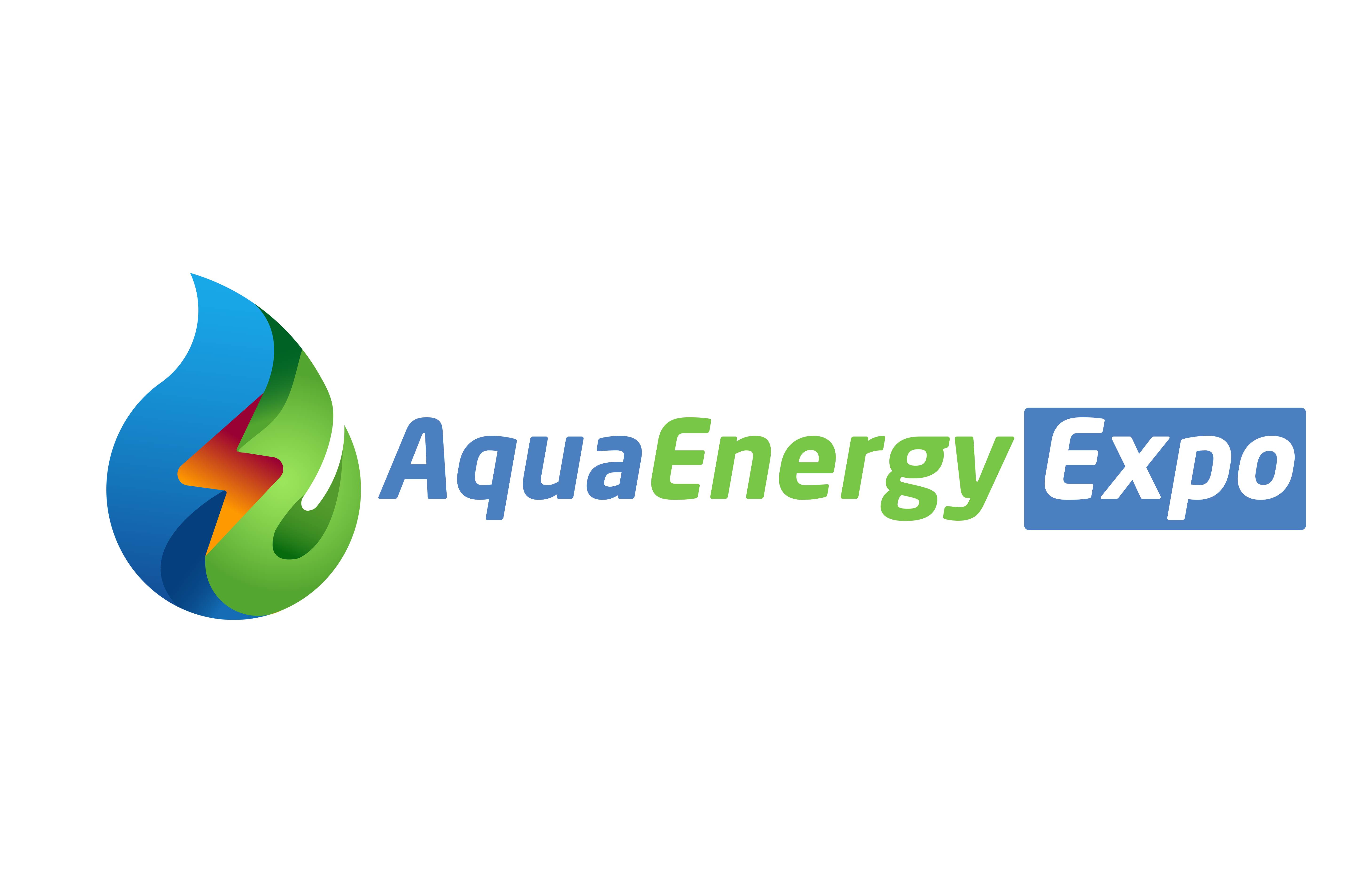



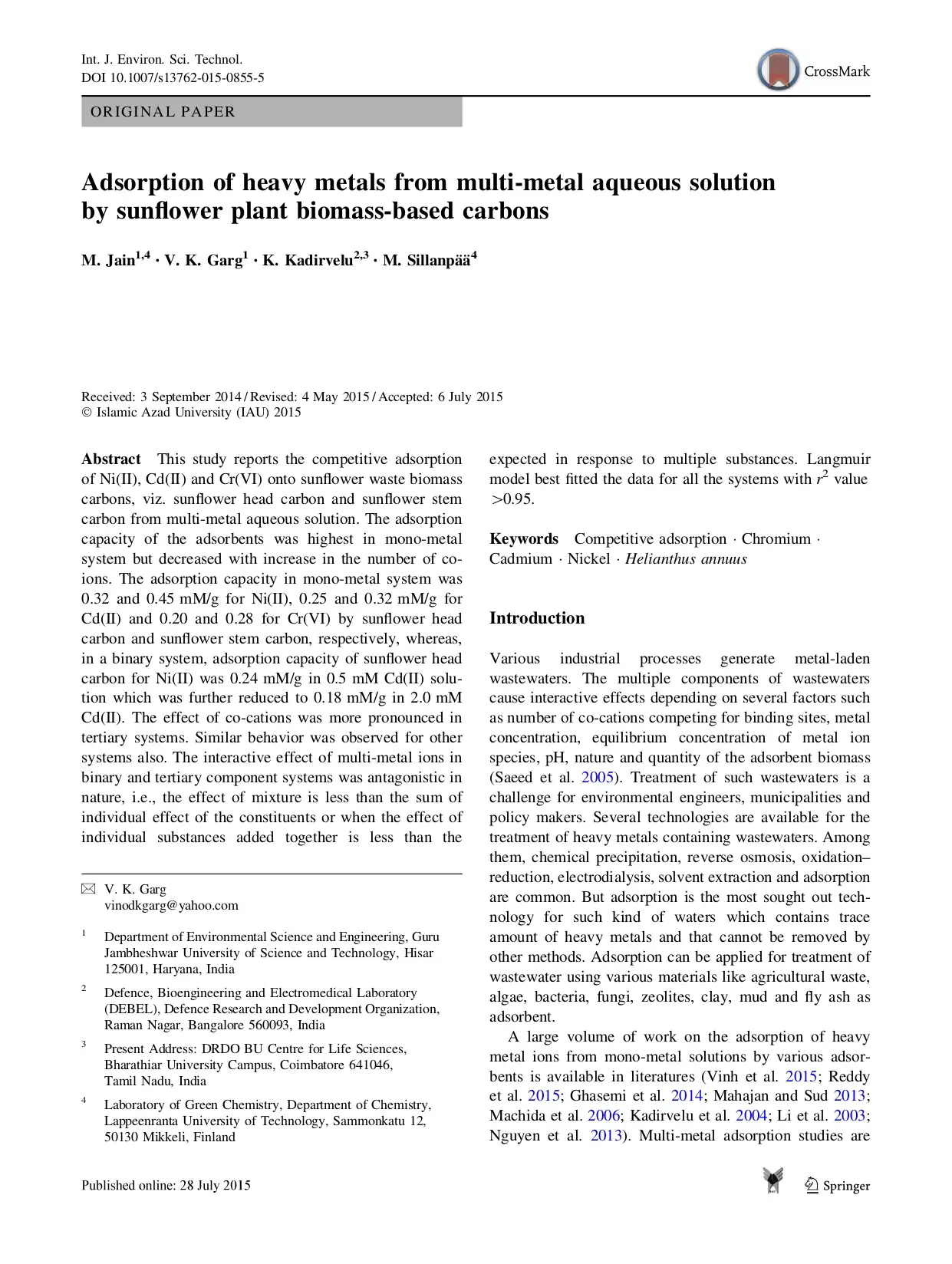
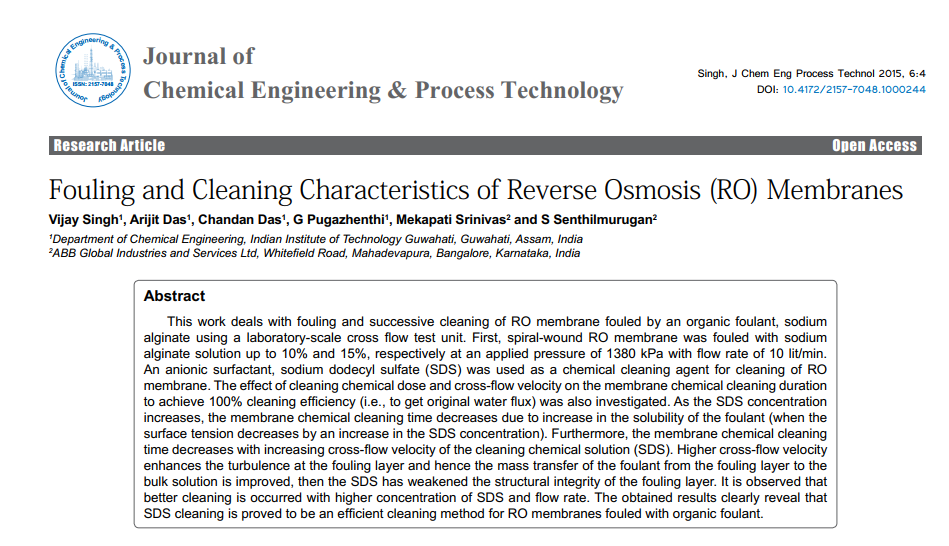
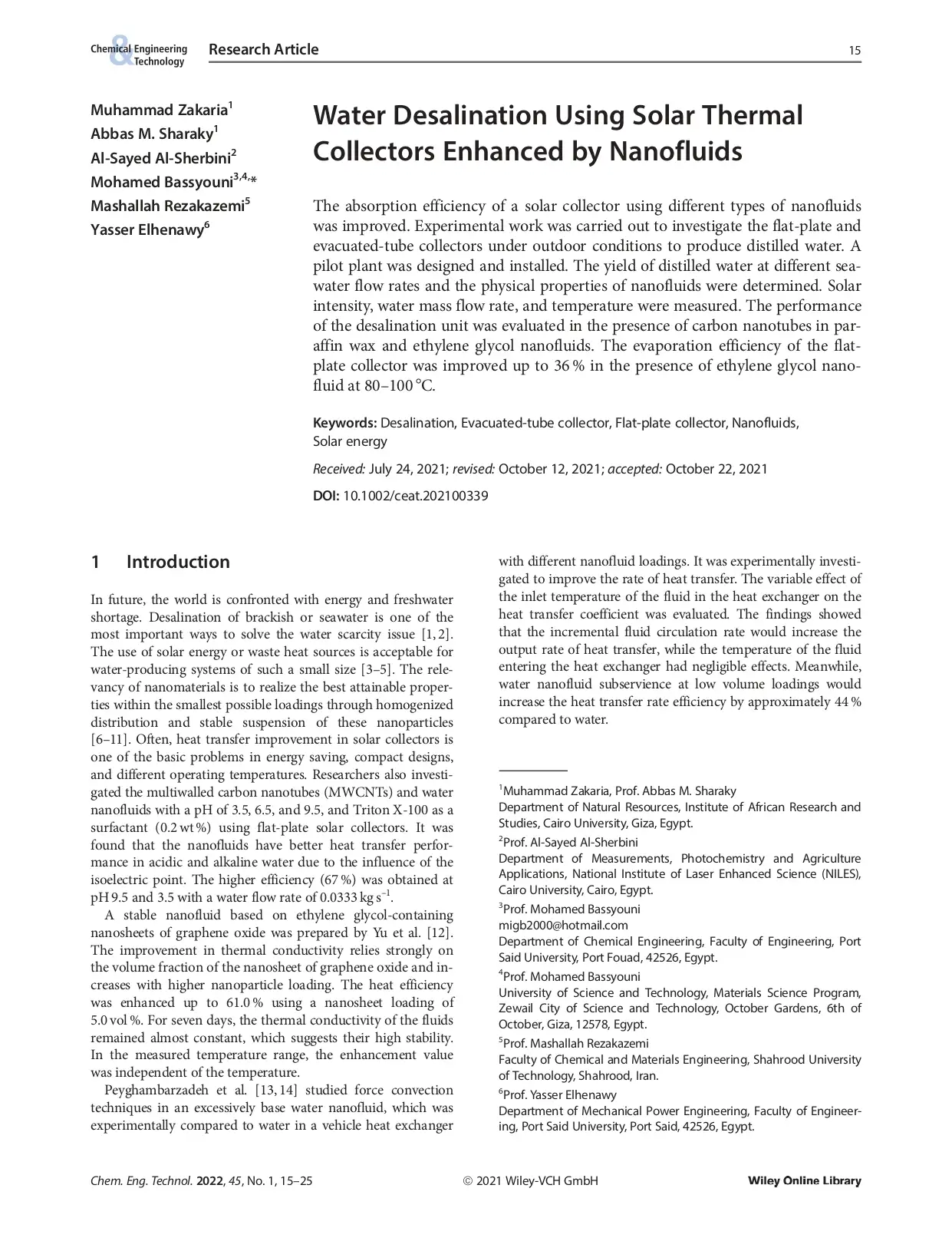
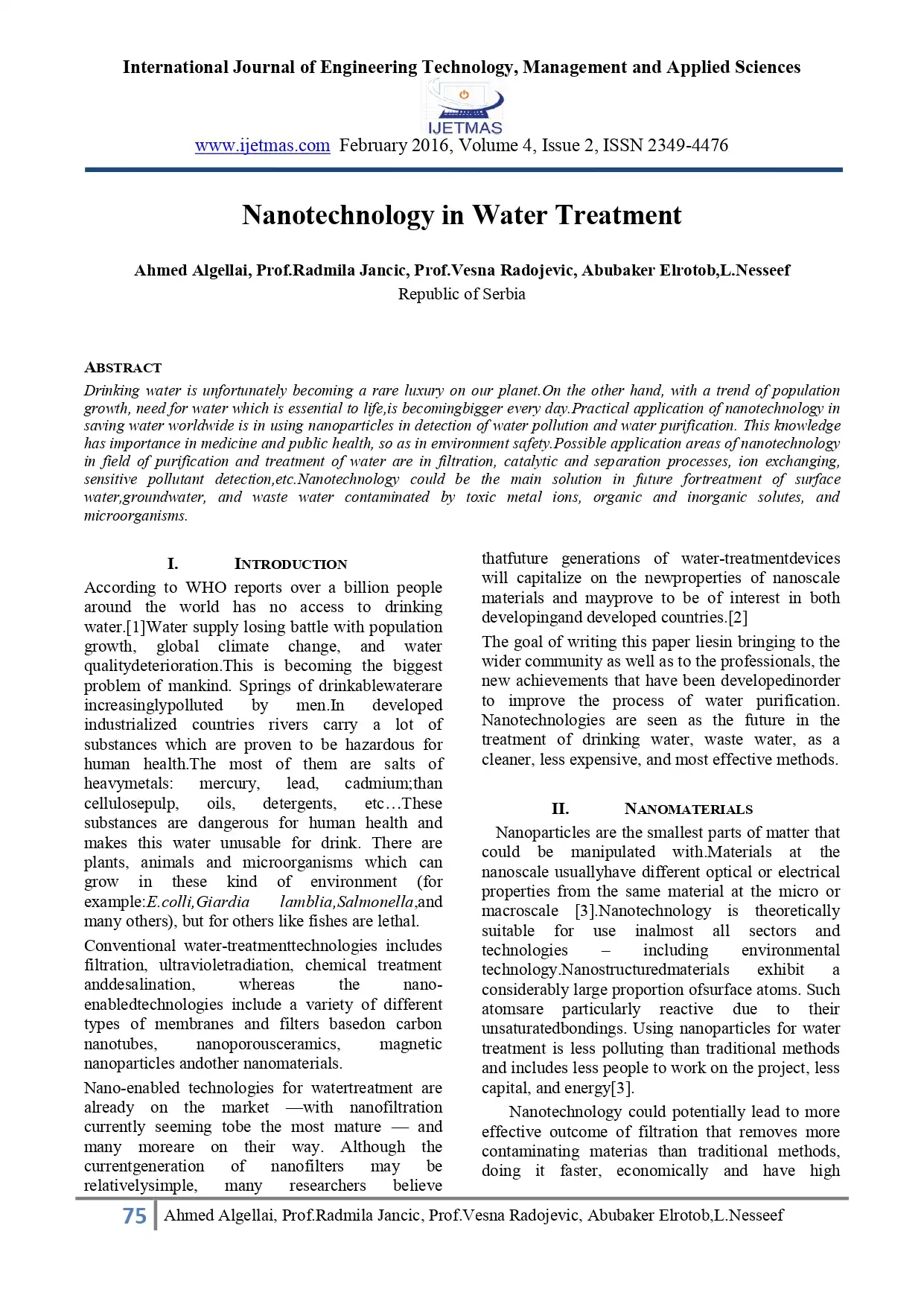
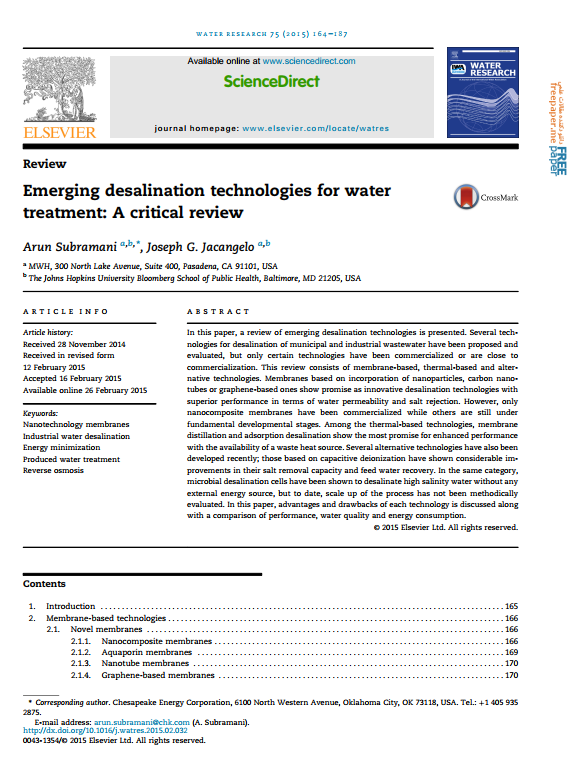
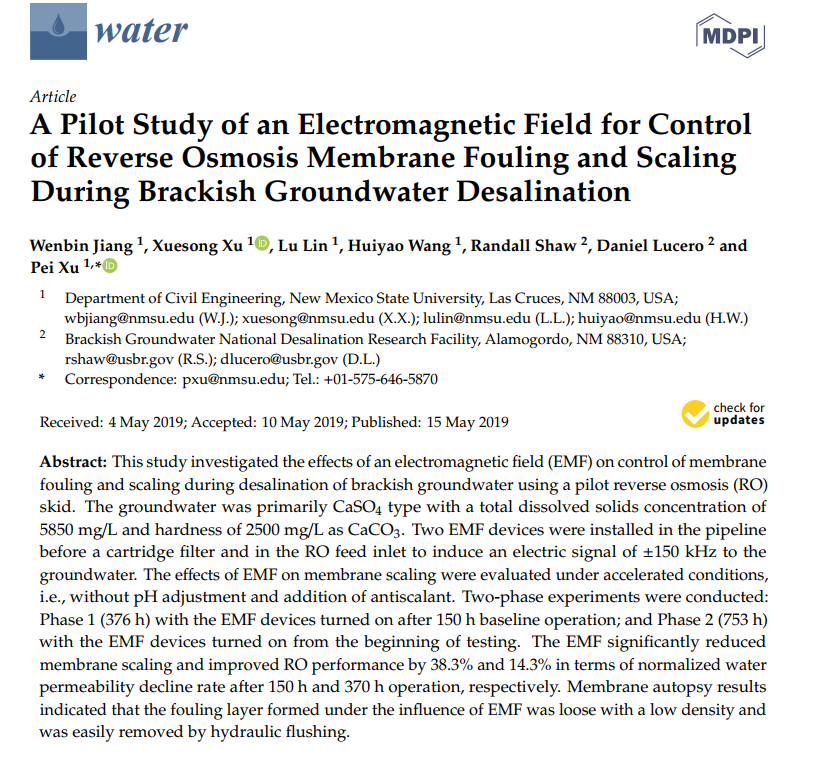


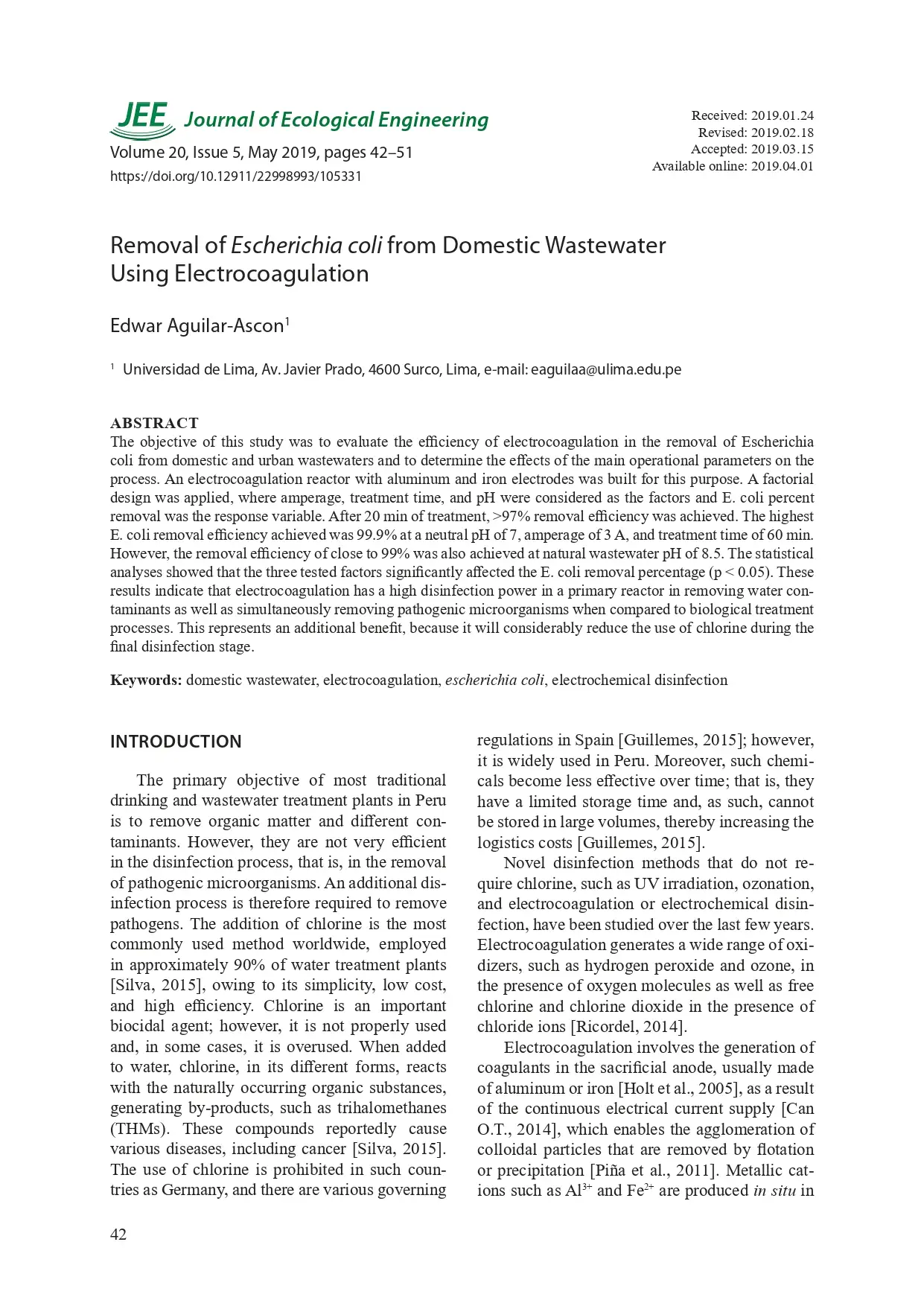
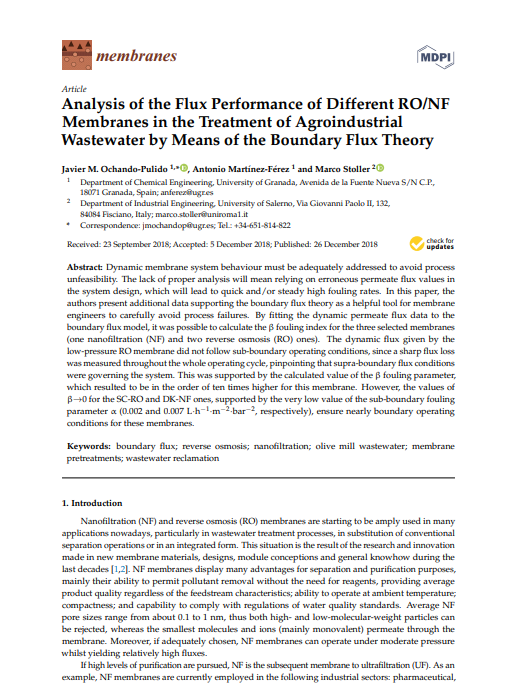
Reviews
There are no reviews yet.